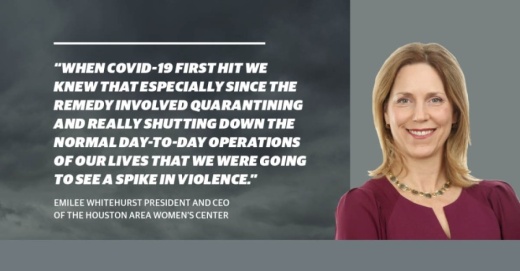What role does the Houston Area Women’s Center play in Houston?
The Houston Area Women’s Center has been on the front lines of responding to interpersonal violence for over 40 years. We serve survivors of domestic and sexual violence, and we serve all people: men, women and children. And sadly, there are thousands and thousands and thousands of people who have been victimized in this community. ... We do crisis response, hospital accompaniment and we have a housing program so when people are fleeing, they go into our emergency housing shelter program. We also have case management to help connect people to a whole range of services. With counseling and legal services, we have found that those components are so critical as people try and rebuild their lives.
Have you seen instances of domestic violence increase since the pandemic began?
When COVID first hit, we knew that especially since the remedy involved quarantining and really shutting down the normal day-to-day operations of our lives, that we were going to see a spike in violence. We saw a huge uptick in calls to our hotline with over 6,000 more than the year before. ... We have three times more women and children in our Safe Harbor Hotel program.
How have you adapted to COVID-19 safety measures?
Normally we help people primarily on a residential campus that houses 120 people, but because we wanted to observe protocols for COVID, we’d be concentrated on shelter. Instead of running one residential campus, we ended up running three; the residential campus and then two hotels. The counseling services went virtual, and we’ve really found actually that in many cases, a lot of the clients have enjoyed that. They’ve appreciated not having to get in their car and drive to their counseling, although I think we’re all yearning to be back together, and we look forward to that as well.
Do you see any of those moving forward that you might keep beyond the pandemic?
I do think the virtual groups and virtual counseling will continue. We also implemented a chat feature on our website because we were really concerned that people, if they were quarantined with their abuser, would not be able to feel that they could make a call to the hotline. That’s been really helpful for people who either couldn’t make a call or just felt more comfortable chatting.
When you added in the hotels, did you find it helpful to have a larger footprint in different areas of town?
I think the footprint in this town is not as significant as just being able to have enough space. The main thing is to have the advantage being on our campus. Then we can definitely ensure there is security. Hotels are wonderful, but they’re not designed primarily for security. Some of our clients have a real security need, and if an abuser finds out where they are, they are surrounded by a really sophisticated security system at the main campus. ...We really are looking forward to developing a new supportive housing residence where we know we can attend to the security issues because we will control the environment.
What changes or new programming are you looking forward to in the next year?
We did a needs assessment of our services thanks to the support of the Houston Endowment. We realized that prior to COVID-19, we were turning away about half of the people who called us and who we knew warranted safety. There’s an evidence-based tool to assess lethality of the situation. The potential danger of being killed, literally. We were having to turn almost half of those people away on any given night. And that doesn’t mean that we lost track of them necessarily. We would be safety planning with them, working with them and trying to find alternatives and maybe eventually they could get into the shelter. But at that moment, we were not able to provide safety on demand, and they deserved it and needed it, and they had done their part. We decided that was just unacceptable. What we were able to do was to secure $15 million for that from the city to build not a shelter, but instead a temporary supportive housing residence on the campus. We currently have some additional land, and so what we’re going to do is build a 135-unit, temporary supportive housing residence that really will afford people the dignity and the security that they need to recover from the trauma that they’ve endured and to rebuild their lives in the wake of that violence and then establish a path forward where they can find permanent housing and create a future where they are no longer reliant financially on their abuser. ... This is not free. And we’re going to need it not just to build it, but to to support it in an ongoing way.





